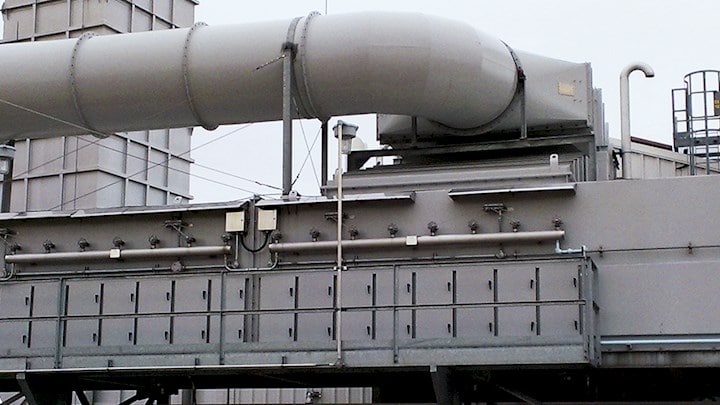
The Watson Cogeneration Plant operates 4 GE, Frame 7EA engines and produces 400 MW for local refineries and sells excess electricity to the grid. The Plant Manager requested air intake efficiency, pressure drop, and water tests from Camfil. The test results revealed the true impact of the synthetic cartridge filters on gas turbine performance.
Energy and Power Systems Case studies
A side by side comparison shows the benefits of higher grade GTC F9 gas turbine air intake filters for two RB211 gas turbines, even in very clean rural areas. It means a cleaner engine, higher power output, fewer water washes, and fuel savings.
Energy and Power Systems Case studiesAn energy plant on the pacific coast upgrades their Siemens 501F gas turbine filtration to the CamGT 4V-300 air intake filters after tests show its water and salt handling capabilities.
Frequent pressure and short filter replacement intervals led to high operational costs. Camfil's Cam-Flo air intake pre-filters and CamGT EPA air filters met their goal of 8000 hours of life and reduced pressure drop by 50%.
A leading steel producer upgraded blower filtration, extending final filter life by 16x, pre-filter life by 4x, and achieving 100% operational availability.
GPSC Thailand upgraded the air filters on six of their gas turbines to TurboPulse T12 cartridge filters, achieving $520 000 USD savings annually, 166 000 MMBtu fuel reduction per year, 8 800 tons of CO2 reduction annually, and 3x improved compressor efficiency
CCC Pesquería in Mexico upgraded to TurboPulse T10 filters, cutting power degradation by 5x, boosting annual output by ~20,000 MWh, adding $600,000+ in yearly profit, and lowering their carbon footprint.
Not all people who purchase our products are experts in air filtration and they shouldn’t have to be either. The purpose of Camfil City is to give everyone a chance to learn the basics of what our clean air solutions can do for them.
Music City Center in Nashville, TN - Hi-Flo ES MERV 13A Air Filters Installed throughout Event Center Improved Indoor Air Quality and Lowered Filter-Related Costs by 34% & Labor Hours by 80%
The wastewater undergoes a long process at Middelfart Wastewater, where the wastewater is treated and at the end of the process it eventually becomes purified water which is then released to the sea surrounding Middelfart. In addition, the byproducts biogas is converted to electricity and heat as well as bio-fertilizer that is being used on farmers’ fields.
Dyna Mig had a competitor dust collector solution that regularly caused costly downtime. With the help of Camfil’s expertise and a flagship Camfil Gold Series GSX dust collector system, Dyna Mig was able to eliminate all unscheduled downtime and cut their heating costs to a minimum – as well as work safer.
With its sina 22 indoor and 6 outdoor courts, PDL at Frihamnen is one of Europe's biggest padel center providers. . Previously an industrial center with different activities, the padel courts ventilation had to be adapted for padel and its 10 000 visotors a week.
Fast food stores are usually located in a crowded commercial area or building where there are problems such as polluted air, gases, and odours. The fresh air fan units in the ventilation system are often close to the pollution source, i.e., exhaust air of other shops in the building.
S.Silpa Co., Ltd., Thailand faced constant odor nuisance and high VOC levels in their factory. This is due to the usage of various chemicals in the printing process that generate volatile organic compounds (VOCs) when exposed to heat, such as thinner solutions, alcohols, inks, cleaning solvents, vinyl sheets.
Handling dust produced due to sugar can be challenging as it is explosive, sticky and abrasive. In this facility, the customer produces soft gummy sweet sugar coated candy and required an efficient and reliable dust extraction solution for a new packaging line.
Ornestation Mors is using air filtration solutions focusing on clean air in stable facilities to prevent the risk of infection. One of the requirements is that Artificial Insemination (AI) studs in Denmark must install filtration or UVC rays in the ventilation system that provides clean, fresh air at the AI facilities to prevent infections among the pigs.
Food2Train's goal is to ensure an optimal hygienic profile of its products and a consequent increase in shelf-life. With this motive, since the start of the plant, Food2Train is working on a concept of cleanroom based environment in the food production cycle. This environment is dedicated to the portioning and distribution of its products hygienically along with eliminating the number of airborne microorganisms from the process to ensure maximum protection of the product.
GO fit Sports Centers were forced to close all its centers in March 2020 when the state of emergency was announced in Spain to tackle the COVID-19 pandemic. Ingesport Group the parent company of the GO fit brand, contacted us to provide a comprehensive solution to reduce the risks of airborne transmission and infection, facilitating a safer indoor environment.
Clean air at a disused nuclear power plant operated by Barsebäck Kraft AB (BKAB) in Sweden. The used nuclear fuels were removed a long time, but demolishing the nuclear power plant is a dirty job that requires maximum safety and control. To keep the air clean in the demolition process, air purifiers from Camfil were used.
Hi-Flo bag air filters and CamGT EPA air filter upgrade reduces compressor efficiency degradation by 80%, slashes 3 offline filter replacements, 7 online pre-filter replacements, and 3 offline water washes per year.
Read the report from the University College of Dublin (UCD) as they evaluate the effectiveness of the City M unit in poorly ventilated environments
G-CON cleanroom application with Gold Series Dust Collector
Clean air in a meat processing facilities
Premium air filters help global grocer significantly improve air quality and reduce maintenance costs, waste and storage
education department Valencia protecting schools
CamPure 32 is the new ideal Camfil media for the removal of hydrogen sulfide during the production of biogas in an anaerobic process. Learn how this farm in France applied the high quality chemical absorbent media to their biogas application.
CamGT 3V-600 static final filters and Cam-Flo GT Hybrid pocket air filters eliminate 6 offline washes per year, improve gas turbine compressor efficiency, and boost power output for a Singaporean coastal cogeneration power plant.
the technical service department at Deventer hospital received complaints several times a year about unwanted diesel odours in different parts of the hospital building. Headaches was one the key problem among the laboratory staff. In operating rooms, the problem was significant because the air is circulated directly from the exhaust vent onto the operating table.
Dance Studios - Improving the air quality and protecting teachers and students
Purifying the air and protecting barber shop and salon customers - Effects of Covid-19
Located offshore Ivory Coast, Africa, the CamGT EPA filter solution saves Foxtrot International 3 shutdowns per year and eliminates salt corrrosion, without compromising on footprint.
Tata Power Ltd, India's largest integrated power company requests Camfil for a Cam-Flo pocket bag filter and CamGT static air filter retrofit after heavy hot corrosion in the gas turbine and high pressure drop jeopardized performance and safety.
Case Study: Air Cleaner Solves Health & Dust Issue. The DB Schenker logistics centre in Önnestad, Sweden now successfully deploys Camfil CamCleaner 6000s for filtering and purifying air in hall areas. Commissioning the CamCleaners did not require major structural alterations.
Dalkia, a leader in the French gas turbine market, launched a national comparative test for various air intake filters, including Camfil's Hi-Flo pre-filters and CamGT EPA filters, to increase power production for their 10 GE LM6000 gas turbines.
Case Study: Clean Air For Cofely United Kingdom. Cofely, a GDF Suez company, is one of the leading experts in energy, technology and facilities management services with business outsourcing. Camfil provides City air purifiers to improve IAQ.
Case Study: Protecting Family-Owned Auto Body Shop. With a reputation as the best in their area, the third generation, family-owned body shop rehabilitates the exterior of foreign and domestic vehicles as well as motorcycles, specialising in classic and specialty cars.
For several years, Hornsgatan has been designated Sweden's dirtiest street when it comes to air pollution. Hornsgatan is an exposed street when it comes to harmful particles in the air. How does this affect residents?